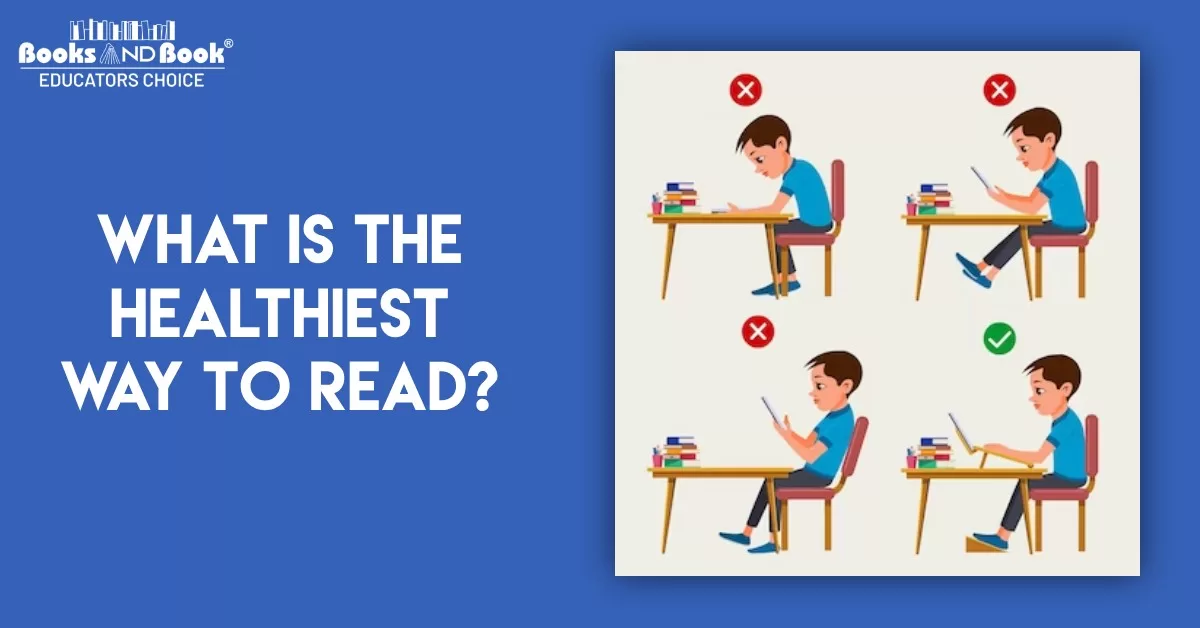The act of reading, entrenched in our culture as a gateway to knowledge and imagination, poses an important question: What is the healthiest way to read?
This query transcends the mere process of word consumption; it encompasses the holistic approach to nurturing our mental and physical well-being through reading.
Embracing healthy reading habits and techniques ensures that our cherished pastime remains beneficial and does not inadvertently become a source of discomfort or strain.
1. Environment and Posture
Creating an environment conducive to reading is not just about comfort; it’s about implementing the best practices for reading without strain. This approach encompasses various aspects, from the physical setting to the posture we adopt while engrossed in a book.
a. Optimal Reading Environment
The optimal reading environment hinges on ensuring good lighting and minimal distractions.
Adequate lighting is not just about brightness; it’s about the quality and direction of light that affects our ability to read without strain.
A well-lit room, preferably with natural light, reduces the risk of eye fatigue. Minimizing distractions is equally important, as it allows for a more focused and thus less straining reading experience.
Ergonomically setting up the reading space, such as having a comfortable chair at the right height, further aligns with the best practices for a strain-free reading experience.
b. Proper Posture
Adopting a proper posture while reading is a critical element of maintaining comfort and health.
The best reading posture for health is, where the back is straight and the book or device is held at eye level, which helps reduce the strain on the neck and spine. This is particularly important during extended reading sessions.
Furthermore, incorporating regular breaks into one’s reading routine is essential. These breaks help in mitigating the risk of physical strain, aligning with the practices of healthy reading habits and techniques.
By stretching, looking away from the book or screen, and perhaps taking a brief walk, we give our bodies and eyes the necessary respite, ensuring a healthier and more enjoyable reading experience.
2. Reading Material and Devices
The choice of reading material and the devices we use for reading significantly influence our overall well-being. It’s not just about what we read, but how we read it, which is why it’s crucial to select reading materials wisely and manage our screen time effectively.
a. Choosing Healthy Reading Material
Selecting reading material that promotes positive mental health is paramount. Literature that uplifts, educates and inspires contributes to a healthier mental state.
Furthermore, diversifying reading materials can lead to a more well-rounded experience.
By varying the genres and types of content we consume, from fiction to non-fiction, and from printed books to audiobooks, we can stimulate different parts of our brain, foster new perspectives, and avoid the mental fatigue that often comes from monotony.
b. Screen Time Management
Managing screen time has become a crucial aspect of reading nowadays. Reducing eye strain from electronic devices is vital for maintaining eye health.
One effective method is the 20-20-20 rule: every 20 minutes, take a 20-second break to look at something 20 feet away. This practice helps in reducing the risk of eye strain associated with prolonged screen use.
Moreover, adjusting screen brightness and using blue light filters can also be beneficial. These measures are essential tips for reading without causing health issues, ensuring that our shift towards digital reading does not compromise our physical well-being.
3. Reading Habits
Cultivating effective reading habits is not merely about quantity, but also about the quality and consistency of our reading experiences. Establishing a balanced reading schedule and practicing mindful reading is key to reaping the maximum benefits from our literary endeavors.
a. Balanced Reading Schedule
Establishing a consistent and balanced reading routine is crucial for a fulfilling reading experience.
A structured routine not only aids in cultivating a steady reading habit but also ensures that reading does not become a source of stress or overwhelm.
Setting realistic reading goals plays a pivotal role in this process. These goals should be achievable and tailored to individual lifestyles and preferences.
Whether it’s setting aside a specific time each day for reading or aiming to finish a certain number of books in a month, these targets can significantly enhance one’s reading journey, making it more structured and enjoyable.
b. Mindful Reading
Mindful reading goes beyond skimming through text; it involves engaging deeply with the material to enhance comprehension and retention.
This practice involves reading with full attention, free from distractions, allowing the reader to immerse fully in the narrative or the subject matter.
Avoiding multitasking during reading sessions is key to mindful reading. By focusing solely on the reading material, one can connect more deeply with the content, leading to a richer and more meaningful reading experience.
Mindful reading not only improves comprehension but also makes the act of reading more enjoyable and rewarding.
4. Physical and Mental Health
The intersection of reading with our physical and mental health is a critical aspect often overlooked. Focusing on eye care and mental well-being is essential for a holistic approach to healthy reading habits.
a. Eye Care
Maintaining good eye health while reading is pivotal. Incorporating specific exercises and practices into our reading routine can significantly reduce the risk of eye strain and fatigue.
For instance, practicing focusing exercises, where the eyes periodically shift from the reading material to a distant object, can help maintain eye flexibility and reduce strain.
Ensuring adequate lighting and adjusting the font size and contrast on digital devices are practical steps in maintaining eye health while reading.
It’s also important to be vigilant about the signs of eye fatigue, such as dryness, irritation, or blurred vision, and to address them promptly, perhaps by adjusting the reading environment or consulting an eye care professional.
b. Mental Well-being
Reading can be a powerful tool in one’s self-care arsenal. It can provide an escape, stimulate the mind, and even foster a sense of peace and well-being.
However, it’s essential to recognize when to take breaks, especially to maintain mental health. Reading intensely emotional or complex material continuously can sometimes lead to mental fatigue.
Thus, it’s crucial to balance reading with other activities and to incorporate breaks into our reading sessions. These breaks can help process the information or emotions elicited by the reading material, contributing to a more balanced and healthy mental state.
Conclusion
In addressing the fundamental query, What is the healthiest way to read?, we’ve explored various dimensions from creating an ideal reading environment to adopting postures that prevent strain, and from choosing enriching content to managing screen time.
The crux of cultivating a healthy reading lifestyle lies in balancing our physical and mental health needs with our passion for reading.
Implementing strategies for healthy reading habits is not just beneficial; it’s essential for a sustainable and rewarding relationship with books and screens alike.
By being mindful of our habits, we can ensure that reading remains a source of joy, knowledge, and wellness, rather than a contributor to strain or stress.
FAQs
Is it better to read in natural light or artificial light?
Opt for natural light whenever possible; it reduces eye strain, making it the healthiest way to read.
How often should I take breaks during prolonged reading sessions?
Take short breaks every 20-30 minutes to prevent eye fatigue and maintain the healthiest reading habits.
Is reading on a screen detrimental to eye health?
Yes, but you can reduce the impact by using the 20-20-20 rule: every 20 minutes, look at something 20 feet away for 20 seconds.
What is the recommended distance between my eyes and the reading material?
Maintain a distance of about 16 inches between your eyes and the text for the healthiest reading experience.
Can the type of font and text size affect the healthiness of reading?
Absolutely, choose a legible font and adjust the text size to ensure the healthiest way to read, minimizing eye strain and discomfort.


